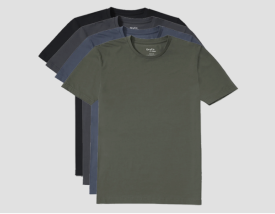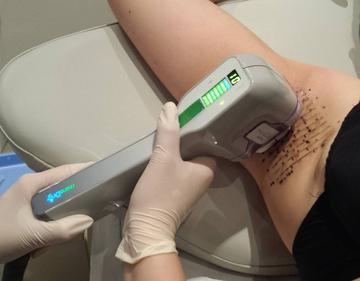Many hyperhidrosis sufferers feel like they are forgotten. There isn’t much research available on the condition, and it doesn’t seem like there’s much discussion about treatment breakthroughs. Or is there? The tables have turned. Medical research and development have actually led to a new generation of hyperhidrosis treatments that offer hope for sufferers. This post will take a look at these treatments, what research says about them, and how they may impact sufferers in the future.
1. Topical Agents for Excessive Sweating
Topical agents technically aren’t new for hyperhidrosis. After all, prescription-strength, aluminum-based antiperspirants have been a staple treatment for the condition from the beginning. But a relatively newer wave of topical agents have started to emerge as a viable treatment option - topical anticholinergic wipes.
Anticholinergic medicines - in pill/capsule form - are a standard option for sufferers, but now, patients can administer them through the skin. In June 2018, the FDA approved the use of wipes containing glycopyrronium tosylate such as Qbrexza™ and Dermira for sufferers of axillary hyperhidrosis (excessive armpit sweating).
A Phase III randomized, double-blind study revealed that these anticholinergic wipes were highly effective at reducing the severity of hyperhidrosis after four weeks of use. One of the great advantages of these wipes is that they carry less side-effects than oral medications since they don’t need to be ingested.
Typically, patients will be required to apply the pre-moistened wipes once daily, on a clean and dry auxiliary area. Once applied, the area can’t be washed. These wipes are a convenient and non-invasive way to treat hyperhidrosis.
2. Fractional Microneedling Radiofrequency (FMR) Therapy for Excessive Sweating
The name of this treatment is quite frankly, a mouthful to say and geeky-sounding. Nevertheless, researchers have pointed it out as a potential game-changer for hyperhidrosis patients thanks to some promising results seen in studies. Although it sounds like something taken from a sci-fi movie, the procedure itself isn’t too hard to grasp.
It works by means of applying insulated microneedles that heat the lower layers of skin (deep dermis), causing constriction and tightening of the skin. It also destroys the sweat glands so that perspiration from the region becomes minimal or non-existent. The needles deliver the heat in a very targeted form, so they don’t destroy the upper and surrounding layers of skin.
FMR therapy lasts 20 minutes, requires local anesthesia and is irreversible. Once administered, the sweat glands can’t be recovered (like surgical removal or cutting of the glands).
As for results, FMR seems very promising. In one report, subjects who underwent the procedure experienced 75% to 80% improvement of symptoms in targeted areas. Some patients noticed an improvement just one day after the procedure or within a week. Others, however, didn’t see significant improvements up until 6 months later.
FMR therapy also seems to produce long-lasting results. Sunil Chilukuri, MD, FAAD, a dermatologist based in Houston, Texas who authored the report said:
"Some patients reported continuing to see a difference at 4 to 8 months following their treatment series, and at one clinic, reported seeing results out to 3 years following a patient's treatment series."
Fortunately, the side-effects of FMR are usually mild, the most common ones being slight edema (water retention), redness and soreness that last for a few days.
Microneedling is becoming an increasingly popular and accessible treatment at dermatology clinics. With that said, the cost of the procedure is on the higher-end compared to other hyperhidrosis treatments.
3. Laser Therapy as a Hyperhidrosis Treatment
We don’t need to spend too much time on this one because laser treatments aren’t new. Laser eye surgery, laser hair removal, laser liposuction - it exists in many forms. However, laser therapy as a hyperhidrosis treatment isn’t on the radar for most sufferers. But it should be.
Laser therapy has been shown to be an effective hyperhidrosis treatment and dermatologists will likely recommend it more to suitable candidates in the future.
In the context of hyperhidrosis, laser therapy works by permanently destroying sweat glands (like surgery and FMR) so that the affected regions no longer perspire. The standard choice is a 1064 nm laser. Typically, patients receive local anesthetic and the procedure lasts just under an hour.
Laser therapy for hyperhidrosis involves a three-step process:
- Locating the sweat glands using iodine and starch
- Creating a tiny incision and then irradiating the affected glands with the laser
- Removing the remnants of the glands
So far, laser therapy has shown a high level of efficacy as a hyperhidrosis treatment. In two studies, following 33 patients over a span of six months, revealed that a session of laser therapy significantly reduced excessive sweating. There were some side effects such as swelling, bruising and numbness, but they were generally mild and resolved after 1 to 2 weeks.
After six months, the lasers were shown to have reduced sweating by as much as 78%.
Laser therapy is likely available at a dermatology clinic near you, but it is important to inquire if the laser and surgeon applying it is suitable for your hyperhidrosis.
Your Future is Looking Dry
The availability of treatments for hyperhidrosis have, at times, seemed limited for sufferers, but the horizon is starting to look bright. New and improved treatments are beginning to hit the market, giving you more options to treat the disorder.
In previous times, you may have felt that your condition (and challenges) were largely overlooked by research. However, the approval of new treatments and the repurposing of existing ones should give you hope that someday, hyperhidrosis will be much easier to manage than now.
Looking for more tips to help you keep hyperhidrosis under control? Check out our NEAT Freaks blog for more insights on staying dry.







